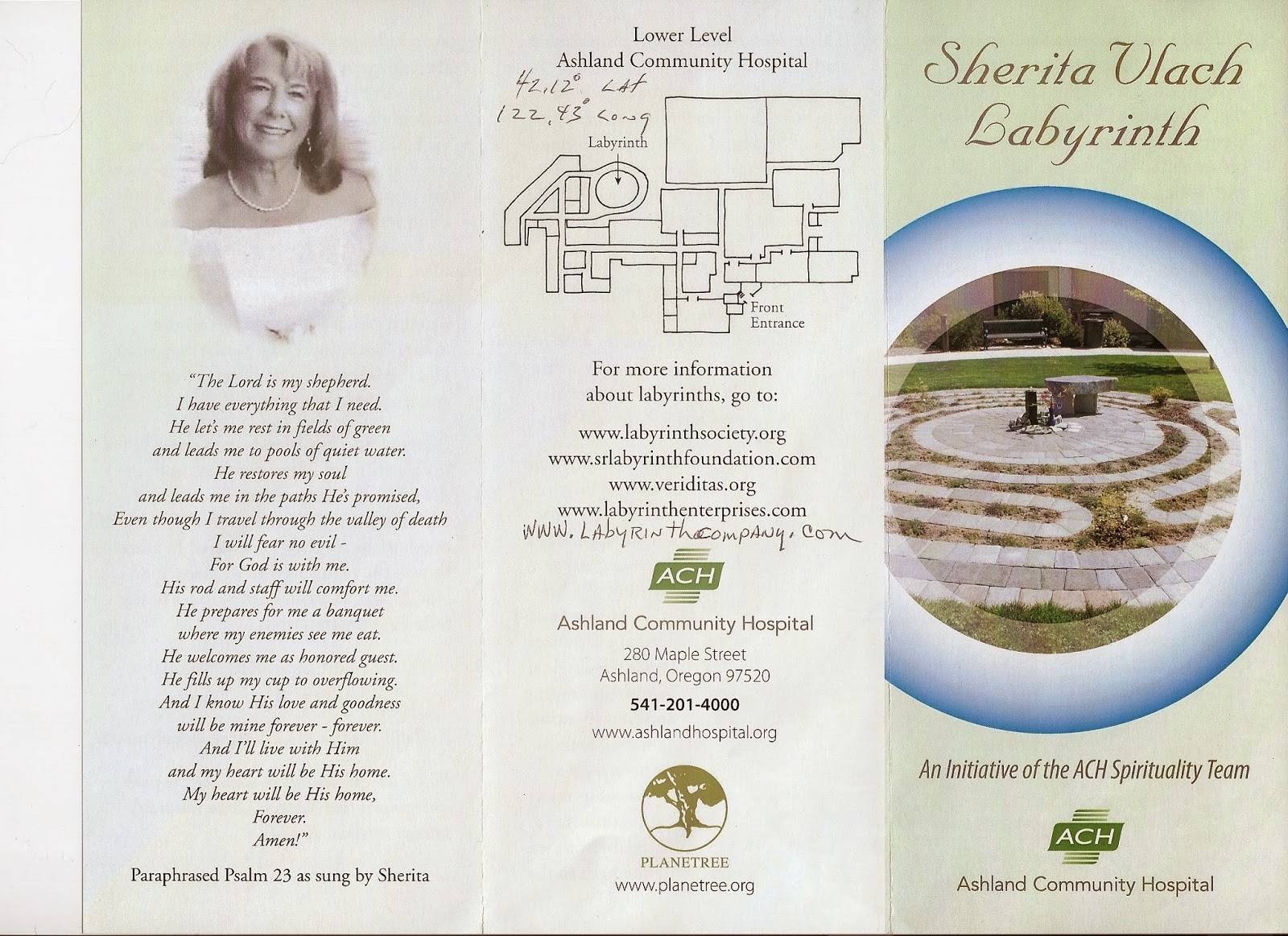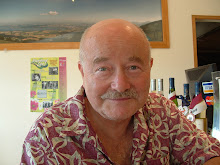Monday, February 16, 2015
THE SPIRIT THAT HEALS!
The Spirit That Heals!
Access Via contemplation is One path or Facet of healing
Or allowing access of the Spirit
Involving Exercise of Solitude And Community Or Solitude Then Community (Nouwen) Example would be the desert then ministry.
Not easy for some. Good technique is breathing the name of God, Yaw Wai.
And sitting in a river and watching the boats go by.
***
Introduction of each to group briefly.
Name and what is interest?
What, if any, faith system or spiritual path
Past experience with labyrinths
Me first
Function as chaplain in local hospitals - Catholic- Lutheran - Path of St Francis of Assisi.
My history with the medium; ***
Sherita and I were married on Mahaulepu by Paul Kirchner, April 28th, 2004.
5 years later she fought a brief battle with Pancreatic cancer, 5 months.
***
The family held a memorial on our beach in August of 2009.
She had some experience with labyrinths as member of our worship team - Not I - However one of our last visits during her clinical trial was to one in PVE *** My last vocation was landscaping and the desire surfaced for me and some friends to construct one in her honor at the place we both worked, Ashland Community Hospital. Winter of 2008-09 ***
About the same time I became acquainted with “The Emergent Church” movement --àwritings of Brian McLaren and esp Richard Rohr. Richard is a Franciscan Priest from Albuquerque NM and heads up the “Center for Action and Contemplation - refer to more in a bit.
He speaks of two halves of life and the transition usually being the result of Great Sorrow Or Great Love >> both of which I had experienced in a few short years.
A key focal point of MY emergence (or transformation) is meeting St Francis again! ***
>> His radical simplicity in life with a focus on Service to ALL and the pursuit of Peace
>> He easily saw and related in a visceral way to All creation and saw God in All.
>> One sculpture in Assisi has Francis imploring the Holy Spirit - With a downward/earth focus
>> Interesting that Francis is credited with beginning the practice of a Nativity scene AS well as the Stations of the Cross. These modalities were used for prayer and meditation during his lifetime as the crusades made pilgrimages to the Holy Land impossible. Some say this was also the use for the labyrinth movement in cathedrals of Europe at this time.
Now as to Labyrinths specifically --
“Labyrinth Society” - “A labyrinth is a single path or unicursal tool for personal, psychological and spiritual transformation”
The difference between a labyrinth and a maze is really quite simple. A maze has high walls, no visual of the center, and multiple dead ends. Examples would be the imprisonment of the Minotaur in ancient Greek Mythology or more recently Jack Nicholson in the “Shining”
***
Last year I was asked to present some of this information to our local Chaplains group in the Rogue Valley. As our Lead put it - to dispel the Woo Woo factor some groups place on the medium.
> They are an art form - and their meaning is just what you put into the practice. No More and No Less.
> They are, more specifically, an ancient to modern art form to facilitate meditation and contemplation using any number, inc 0, of ritual exercises in the process.
> Every culture and most religious systems have embraced some form of solitude or meditation to achieve balance in your daily life.
Some over the centuries have attributed magical qualities to the practice - In my opinion that speaks more to the power of the human mind.
It is worth considering the nature of the circle (although labyrinths are not universally circular)
Circles signifies unity and the building blocks of All creation --Two specific examples meaningful to my path are the Celtic Cross and the Trinity.
Interview with woman author, Paula?, re: 1st Century instrument of Roman torture and Christianity - spoke of usual path of death and resurrection but then spoke of the circle of the Celtic Cross as tying all of creation to the symbol for the Christian God.
Secondly the concept of the Trinity has never been easy to clarify however it has been stated that the early church used a Greek word to so describe. Perichoresis - best translated into the vernacular as “Circle Dance” - A relationship or describing God as more of a Verb than a Noun.
Richard again - “These circular paths are a way of learning and praying through movement instead of through thinking”
“Labyrinths seem to have emerged from the collective unconscious, representing a clear path to the center, to the Divine.”
“The turning circuits of a labyrinth remind us that life is change and transformation, and repentance.”
I believe that a labyrinth can possibly be seen as a man’s path to contemplation - Please forgive the stereotype - but it IS a Walking path..
The final analysis as to an “Instruction” in walking a Labyrinth, in my opinion, is to:
RELEASE - on the path inward your cares!
MEDITATE - in the Center (on the Divine)
RECIEVE - on the path outward (from the Divine)
As to Construction:
Construction materials are as varied as the developer desires, but the most common are concrete stamped or inlayed, paver stones, bricks, rock(more natural), or other boarder materials such as logs or low edging plants (Thyme or Lavender). The pathway in like manor is wide open but should be user friendly - width and smooth surface (fine bark or decomposed granite are good)
Especially if outdoors labyrinths are considered a touch point with nature, the Earth and Creation which many consider to essentially be the First bible.
Many have a cartological orientation of NSEW but not always (based on site limitations). Mine usually do.
Numerology or specific numbers have been used in much scripture and I have used them myself. 7/10
Some have used Sacred Geometry in planning their structure but has not been my experience. Only say that one could use the ratio of the Golden Mean, 1.618, in sizing the circuits, result in expanding concentric circles would be interesting to install. Phi is found in many natural events and structures. In philosophic circles the Golden Mean is a middle point or path and a way of expressing non duality in life. ***
Actual shapes vary the world over as we are about to see. You will find examples in virtually every culture and era in human history and pre history.
*** The “Classical” style has 7 circuits (representing the 7 stages of life) and is most often associated with ancient Greece. However seven circuits may be of different styles.
Some examples of other unique Labyrinth type structures are:
The Mayan culture
The North American Medicine Wheel ***
The Tibetan Mandala ***
“Heihu”??
A "johnny come lately" is the French 11 circuit “Chartes” style which has actually become one of the most popular in the West. My angst with width of paths could actually be an opportunity.
Other notably distinctive patterns from the Labyrinthcompany.com website include;
***The “Baltic Spiral” which is very useful for a continual flow in and out.
*** A “Ceremonial” style which is designed to allow two individuals to take separate paths to the center and then exit a third entry together.
***
Take a look at the three I’ve been instrumental in installing and then we are going to build one together.
*** Sherita’s first specific memorial is in Ashland, Oregon. It is of a five circuit (because of available space) Neoclassical Chelsea design (Labyrinth Co) incorporating a water feature (symbolizing the life sustaining nature of God) and a Granite bench in the center. The hardscape is utilizing paver stones and several memorial plaques. *** ***
***Sherita’s seven circuit on Mahaulepu beach is constructed of 99.9% native rocks and is in probably one of the best places on earth for meditation and community with God. My son Michael and I mostly installed over 5 days on what would have been our 10th . Renamed that bluff “Momilani Kai” Heavenly Pearl by the Sea. *** ***
The third is basically the same pattern *** but dramatically different in many ways. It is still in process, and will be for sometime. It is called a “Franciscan Style” as the path wanders between trees and boulders instead of needlessly removing them, hence attempting to honor nature. The labyrinth may be walked in silence OR there are some “cookies” with inspirational quotes for reflection…*** *** ***
Our exercise is a seven circuit classic from “Labrinthos”. The materials are one rope, sand, wooden stakes and empty milk jugs.
Resource List:
Labyrinthcompany.com
Labyrinthsociety.org
Veriditas.org
labyrinth locater.com
Labyrinthos.net/layout.html
Subscribe to:
Posts (Atom)





































